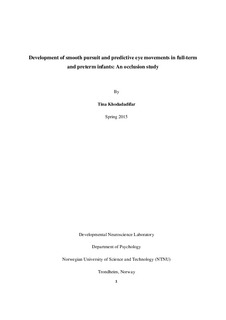| dc.description.abstract | When a moving object disappears behind an occluding surface, the prediction of its reappearance must be made across time and space and this not only requires a maintained representation of the existence but also the representation of the trajectory and future location of the object. Developing stable object representations is a remarkable improvement of infants’ capability to coordinate visual perception and motor control in everyday life, where we are constantly surrounded by motion. However, infants born<32 gestational weeks are at high risk of developing later disabilities in such higher brain functions. In view of this (background), the present study investigated the development of infants’ understanding of object permanence and the impact of premature birth on the visuo-motor system. This was done by evaluating the infants’ capacity to follow, maintain attention and predict the direction of a moving object in an occlusion task. Three groups of normally developing infants including two groups of full-term infants (tested at 5 and 12 months of age), and a group of preterm infants (tested at 12 months of age) were presented with an object moving repeatedly in a linear horizontal path during which it disappeared behind an occluder. Results revealed that full-term infants’ ability to smoothly track a moving object undergoing occlusion and to predict its reappearance increases considerably between the ages of 5 and 12 months. These improvements have been attributed to neural maturation in conjunction with an increase in visual experience. Impairments were found in the smooth pursuit systems of 12 month-old preterm infants, while their capacity to make anticipatory eye movements was relatively similar to their full-term term peers. This could be attributed to white matter abnormality related to visual dorsal stream vulnerability or other neonatal complications. It is not evident whether this reflects a delay in dorso-visual pathways in preterm born infants or a persistent functional limitation in visuo-motor capacity. | nb_NO |
